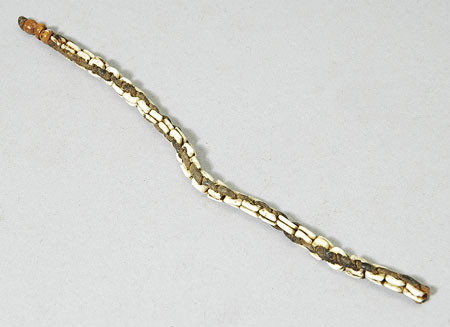Accession Number:
1940.7.075
Country:
Sudan
Region:
[Southern Sudan] Eastern Equatoria Didinga Hills Chukudum
Cultural Group:
Didinga
Date Made:
By 1940
Materials:
Ostrich Eggshell Bird , Stone , Animal Hide Skin
Process:
Chip Carved , Perforated , Strung , Knotted
Dimensions:
L = 160 mm, W = 6, th = 5.5; typical eggshell bead L = 5.5, W = 5.5, th = 1; stone bead diam = 4.5, th = 4; hide strips W = 2 mm [RTS 2/3/2005].
Weight:
4.8 g
Other Owners:
Samuel P. Powell
Field Collector:
Samuel P. Powell
PRM Source:
Samuel P. Powell
Acquired:
Loaned July 1940
Collected Date:
By 1940
Description:
A beaded string that has broken away from a girl's apron.
This consists of a series of small square beads carved out of pieces of white ostrich eggshell and pierced through the centre, stacked in pairs and threaded alongside each other by passing 2 narrow hide thongs in and out of the holes in a running, figure-of-eight pattern.
There are 26 of these pairs.
At the top end, the last of these loops is broken, presumably where it was attached to the original object.
At its base, the hide strips come together to form a single cord, onto which 3 small brown stone beads have been threaded (Pantone 470C), then fixed in place with a single knot at their base.
The hide strips are brown (Pantone 7532C) and somewhat accreted with dirt.
This part of the object is complete in itself, except for the broken loop mentioned above.
It has a weight of 4.8 grams, and is 160 mm long, 6 mm wide and 5.5 mm thick; a typical eggshell bead measures 5.5 by 5.5 mm and is 1 mm thick, while the brown beads have a diameter of 4.5 mm and are 4 mm thick, and the hide strips are 2 mm wide.
This object was collected by Samuel P. Powell at Chukudum, in the Didinga Hill area of Eastern Equatoria, and loaned to the Pitt Rivers Museum in 1940. The Didinga are found in this region of the Southern Sudan, and in northeastern Uganda; their language has similarities to the Longarim and Murle (http://www.ethnologue.com/show_language.asp?code=DID). Powell commented that he was unable to get a complete example of one of these aprons, and had to be satisfied with a fragment.
The ostrich eggshell beads used in this object may have been made by chipping the material to the correct size then boring a hole through it, after soaking the eggshell in water to prevent the material splitting. Several partially worked beads could then be strung together and the edges ground to finish them off. It was possible to make around one hundred beads of this kind per day (M. Carey, 1986, Beads and Beadwork of East and South Africa, p. 9).
Rachael Sparks 14/9/2005.
This object was collected by Samuel P. Powell at Chukudum, in the Didinga Hill area of Eastern Equatoria, and loaned to the Pitt Rivers Museum in 1940. The Didinga are found in this region of the Southern Sudan, and in northeastern Uganda; their language has similarities to the Longarim and Murle (http://www.ethnologue.com/show_language.asp?code=DID). Powell commented that he was unable to get a complete example of one of these aprons, and had to be satisfied with a fragment.
The ostrich eggshell beads used in this object may have been made by chipping the material to the correct size then boring a hole through it, after soaking the eggshell in water to prevent the material splitting. Several partially worked beads could then be strung together and the edges ground to finish them off. It was possible to make around one hundred beads of this kind per day (M. Carey, 1986, Beads and Beadwork of East and South Africa, p. 9).
Rachael Sparks 14/9/2005.
Primary Documentation:
Accession Book Entry
[Loans II, p.
308] - ESTATE OF S.P.
POWELL, C/O N.H.
HASLAM, Esq.
Manager, Westminster Bank, Stony Stratford, Bucks.
Collected by himself.
Data from his labels and notes.
[p.
312] From the DIDIGNA (DODINGA) tribe, ANGLO-EGYPTIAN SUDAN (southern border).
1940.7.075 - String from girl's sporran made from ground ostrich-egg-shells (square
discs
pieces).
CHOB
A
DUM.
DIDINGA MOUNTAINS [the letters 'HU' are inserted above the 'BA' of 'Chobadum', with the latter partially crossed out].
Related Documents File - Appears on undated typed list: "Section or strand from Didinga girls sporran made from ostrich egg shell. I was quite unable to get a whole sporran". List is annotated by hand on back: "List of Curios" and "Far from complete" [RTS 16/12/2003].
Pitt Rivers Museum label - String from girl's sporran made from ground ostrich eggshells. DIDINGA. Chuhudum (?), Didinga Mtns. S.P. Powell [brown luggage label, tied to object; RTS 2/3/2005].
Related Documents File - Appears on undated typed list: "Section or strand from Didinga girls sporran made from ostrich egg shell. I was quite unable to get a whole sporran". List is annotated by hand on back: "List of Curios" and "Far from complete" [RTS 16/12/2003].
Pitt Rivers Museum label - String from girl's sporran made from ground ostrich eggshells. DIDINGA. Chuhudum (?), Didinga Mtns. S.P. Powell [brown luggage label, tied to object; RTS 2/3/2005].



